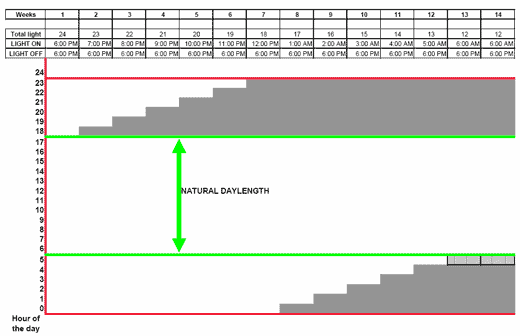Lighting programme in hot climate houses: Between Latitudes 20° north and 20° south

In tropical and subtropical countries, the layers are subjected to important heat stress. This heat stress can occur during long periods. The lower feed intake noticed during these periods is the result of the bird’s reduced ability to lose heat.
The lower growth rates during rearing and the reduced production during lay are only consequences of the reduction in feed consumption when the birds are incapable of regulating their internal body temperature.
High temperature and growth
The growth is affected when the birds approach full plumage. The growth is mainly affected after 6 weeks old.
The deterioration of the growth rate usually observed lead to a delay of the sexual maturity.
Indeed, without any light stimulation, the pullets start in production when they reach their ideal bodyweight. Later this bodyweight will be achieve, later will start the production.
Therefore, it is essential in these conditions of rearing and production to encourage growth during all the rearing period starting with:
- Good brooding conditions in order to get the best bodyweight as possible at 5 weeks old and a good uniformity
- As the growth rate is related to light duration, we advise to use a slow step down lighting
programme which will help to boost feed consumption and growth.
- The reduction of light duration done in the evening will allow the birds to eat early in the morning during the cooler part of the day and help the bird to lose easily the specific heat of digestion before hotter part of the day.
- After 6 weeks, giving the feed early in the afternoon will encourage feed consumption of large particles size (low energy needed) before the light off. Fine particles will be easily eaten in the morning. This meal feeding will encourage the development of the digestive tract and help the increase of consumption at start of lay.
It is primordial to encourage growth instead of sexual maturity.
- A too low bodyweight at start of lay will lead to post peak dips, risks of high mortality in production with some prolapsus, and poor quality and persistency later on in production.
- A too early light stimulation will lead to post peak dips. No light stimulation is necessary before 2 % Increase of light stimulation from 2 % of lay could be done in the morning to boost feed consumption during the cooler part of the day.
Please find herewith a lighting programme for rearing in hot climate (Between Latitudes 20° north and 20° south). It is only a guide that could be adapted to local conditions.










.jpg&w=3840&q=75)